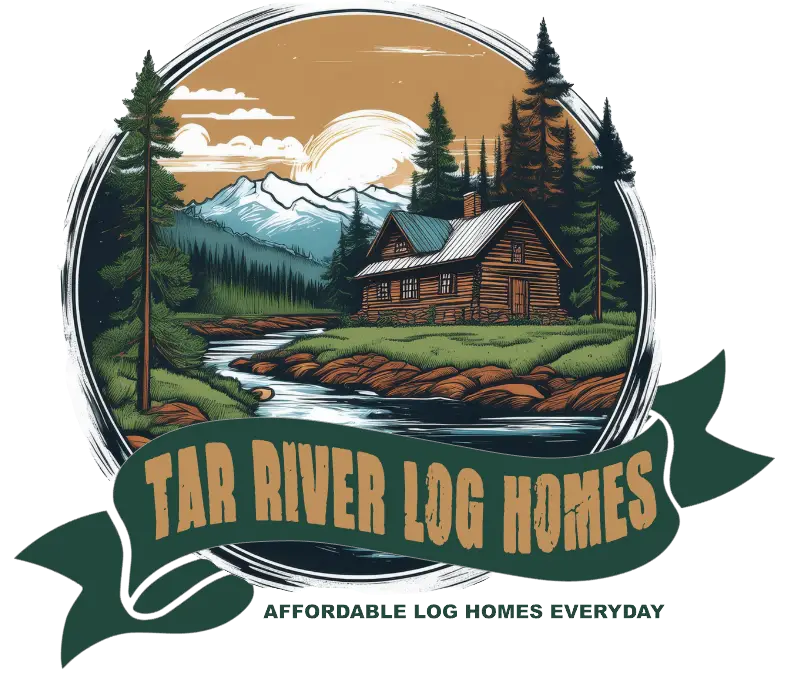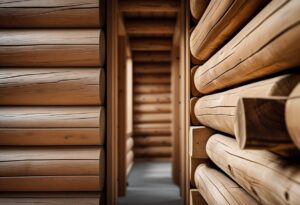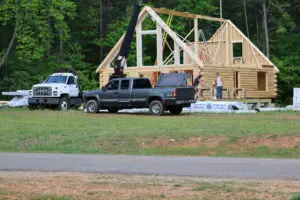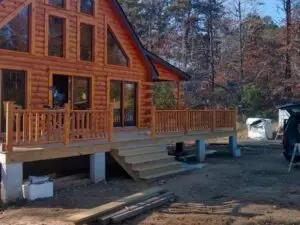When planning a log home, one of the first choices you’ll face is deciding between log cabin siding and full log construction. Both options create a rustic, timeless look, but the cost, upkeep, and building process differ greatly.
Tar River Log Homes helps families understand these trade-offs so they can make confident choices. Whether you’re prioritizing budget, energy efficiency, or authenticity, knowing the details up front makes the process smoother and less stressful.
In this guide, we’ll compare siding and full log homes side by side—covering costs, durability, energy efficiency, and maintenance. By the end, you’ll know which option fits your cabin goals and lifestyle best.
What Is Log Cabin Siding?
Log cabin siding is designed to give your home the classic log cabin look without the need for full logs. It offers a rustic appearance while being easier to install and maintain. You’ll find a variety of materials and styles that balance aesthetics with practicality.
Materials Used for Log Cabin Siding
Most log cabin siding is made from wood species like pine, cedar, or cypress. These woods are popular because they naturally resist decay and insects, making them durable choices for siding.
You might also find engineered wood options, which provide similar looks but can offer added protection against moisture and warping. The wood often undergoes treatment or sealing to enhance weather resistance.
This means your siding will stand up better to rain, sunlight, and temperature changes. If you want less maintenance, some siding products come pre-stained or pre-finished, saving you effort over time.
Common Styles and Profiles
Log cabin siding usually mimics the look of full logs by featuring rounded or half-round profiles. You can choose from full log siding, which looks like thick, rounded logs stacked horizontally, or half-log siding, which is thinner and lighter but still captures the log cabin charm.
Other popular profiles include tongue and groove designs that fit tightly together, improving insulation and reducing drafts. These profiles also simplify installation and create a seamless, authentic look on your home’s exterior.
What Is Full Log Construction?
Full log construction involves building walls entirely from large, solid logs. These logs serve as both the structural support and the outer surface of your home.
You’ll find this method offers a natural, rustic look with excellent durability and insulation. You can choose from different types of full log walls depending on the log shape and how the logs fit together.
The building process itself often uses traditional techniques that highlight craftsmanship and precision.
Types of Full Log Walls
Full log walls come in several styles, each affecting the home’s appearance and performance.
- Scribed (or scribe-fit) logs: Logs are carefully shaped to fit tightly together using a scribing process. This creates a tight seal that helps with energy efficiency.
- Dovetail corner logs: These logs interlock at corners with a wedge-shaped cut. This offers strong stability and a classic look.
- Chinked log walls: Logs with visible gaps filled with a sealant called chinking. This method was used historically but is less common in modern builds.
- Round vs. square logs: Some full log homes use rounded logs, while others use milled, flat-sided logs for a smoother appearance.
Knowing these types helps you decide how much maintenance you want and what aesthetic fits your taste.
Traditional Log Home Building Techniques
Traditional log building focuses on handcrafting logs to fit snugly and securely. Each log is typically peeled, dried, and shaped on-site or at the mill.
The process includes notching corners and scribing logs to ensure tight, weather-resistant joints. Notches like a saddle or a dovetail create interlocking corners that lock logs in place without nails.
You’ll often see builders chink or seal gaps to improve insulation and prevent drafts. This approach relies more on skill and less on modern framing materials.
Visual Differences Between Log Cabin Siding and Full Log
When comparing log cabin siding and full log construction, you’ll see distinct contrasts in both how the exterior looks and the feel inside your home. These differences can influence your choice depending on the style and atmosphere you want to create.
Exterior Appearance
Full log walls are made from large, solid logs stacked horizontally. You’ll notice natural variations in shape, texture, and color, giving your cabin an authentic, handcrafted look.
The logs also create deep grooves between each course, which adds to that classic log cabin charm. Log cabin siding, on the other hand, is thinner and often manufactured to mimic this look.
It can be either full log siding or half-log siding, with half-log being lighter and easier to install. Siding is generally more uniform in color and shape, and it attaches to traditional framing rather than forming the entire structure.
If you want a rugged, genuine log feel on the outside, full logs deliver that. If you want the log cabin look with simpler maintenance and a cleaner finish, siding works well.
Interior Aesthetics
Inside, full log construction means every wall is a solid log, showing natural wood grain, knots, and seasonal checks. This creates a cozy, earthy atmosphere with genuine texture that you can see and feel.
The interior logs also contribute to the cabin’s thermal mass, gently regulating temperature. With log siding on the interior, you don’t get exposed full logs except where the siding might be visible on exterior-facing walls.
Instead, walls typically have standard framing and insulation underneath the siding, then covered with drywall or paneling inside. This results in a more finished and uniform interior appearance, but lacks the tactile log wall experience.
If the interior wood’s authenticity and texture matter most to you, full logs give you a rich, natural ambiance. Siding favors practical, standard interior walls with just the exterior log appearance.
Structural Comparison
When deciding between log siding and full logs, you’ll want to consider how each option stands up to wear and how well it insulates your home. Both affect the feel and function of your cabin differently.
Durability
Full logs serve as both the structure and exterior of your home. They are thick, solid wood, which provides strong resistance against wind, impacts, and extreme weather.
Because the logs are load-bearing, they create a sturdy shell that can last for decades with proper care. Log siding, on the other hand, is a decorative layer attached over a traditional frame.
It doesn’t support the building’s weight but does protect the underlying materials. It’s generally easier to repair or replace than full logs because it’s lighter and less integral to the home’s stability.
In summary:
- Full logs = structural, heavy-duty, withstand harsh conditions
- Log siding = non-structural, easier maintenance, less impact resistance
Insulation Properties
Full log walls provide natural insulation because of the solid wood’s thickness. Logs slow heat transfer, helping keep your cabin warm in winter and cool in summer.
However, individual logs can have small gaps or shrinkage over time, which may require regular sealing maintenance. Log siding itself offers little insulation since it’s just a surface layer.
Your home’s framing and standard insulation materials account for the thermal performance in this case. This means your energy efficiency depends more on the quality of the framing insulation than the siding.
Here’s a simple breakdown:
| Feature | Full Logs | Log Siding |
| Insulation Level | Moderate to high natural insulation | Dependent on framing insulation |
| Maintenance | Requires sealing gaps | Framing insulation maintenance |
| Energy Efficiency | Durable thermal mass | Varies with insulation quality |
Installation Processes
The installation of log cabin siding and full log construction involves different techniques and timelines. Each method requires specific tools, preparation, and skill levels.
Installation Steps for Log Cabin Siding
Log cabin siding is typically installed over a standard framed wall, which simplifies the process. You start by preparing the exterior wall, ensuring it is clean, dry, and properly insulated.
Next, install a moisture barrier to protect against water damage. Then, attach furring strips to create an air gap for ventilation behind the siding, which helps prevent rot.
You nail or screw the log siding panels horizontally onto the furring strips, making sure to stagger the seams for a natural look. Seal all joints with caulk or appropriate weatherproofing to block drafts and moisture.
The entire process is relatively fast and requires fewer specialized tools compared to full log construction.
Full Log Construction Process
Building with full logs is more involved, requiring careful handling of large, heavy timber. You begin by selecting and preparing logs, often debarking and sometimes treating them for pests.
Logs must be carefully notched and fitted together using traditional joinery like saddle or dovetail notches. This fitting ensures tight connections and structural integrity.
The logs are stacked horizontally to form the walls, with attention to settling and shrinkage over time. Gaps between logs are filled with chinking or caulking to seal against air and water infiltration.
Because this method builds the whole structure from logs, it demands more time, skill, and specialized equipment than installing siding.
Cost Considerations
When choosing between full logs and log siding, you’ll want to weigh the upfront material costs alongside the labor and time needed for installation. Both factors impact your budget and project timeline significantly.
Average Cost Comparison
Understanding price ranges helps you plan realistically. According to HomeGuide, installing log siding costs between $8 and $15 per square foot. In contrast, full log construction can reach $20 to $35 per square foot or more, depending on species and craftsmanship.
This means siding often comes in at less than half the cost of solid log walls, making it a budget-friendly option for many homeowners.
Material Costs
Full logs typically cost more per square foot than log siding. You can expect full log materials to include large, solid timber pieces that are naturally thicker and more substantial.
This drives the price up due to the quality and quantity of wood required. Log siding ranges from around $3 to $15 per square foot installed. The price can vary based on wood species and siding style. It gives you the log look but uses less wood overall, which lowers the cost.
If you want to manage a budget, partial log siding or accent walls with log panels can also be more affordable options.
Labor and Time Investment
Installing full logs is more time-consuming and labor-intensive. Logs require precise fitting, sealing, and often specialized skills to ensure structural integrity and insulation.
Log siding is faster and easier to install because it mounts over standard framing. You might save weeks of construction time compared to full logs.
Also, siding installation is often less expensive since it demands fewer specialized craftsmen.
Maintenance Requirements
Maintaining a log cabin siding or a full log home means paying attention to specific needs to protect your investment. You’ll want to focus on routine care that preserves wood quality and handle repairs promptly to avoid bigger problems.
Long-Term Upkeep
For full log homes, you need to apply sealants and stains every 3 to 5 years to protect against moisture, UV damage, and pests. Regular inspections for cracks or gaps are crucial since these let in drafts or water, leading to rot or insect entry.
With log siding, upkeep tends to be simpler. The materials are often pre-treated and easier to clean.
You should still check for damage, but replacements or repairs are usually less complicated and less frequent compared to full logs. Both types require periodic cleaning to remove dirt, mold, and mildew.
Make sure to use gentle cleaners that preserve the wood finish. Keeping gutters and drainage systems clear will help prevent water damage to the wood.
Common Repairs Needed
Cracks and splits are common issues in full log walls, especially as the logs naturally shrink or expand with weather changes. You’ll need to fill these with chinking or caulking to maintain insulation and keep pests out.
For log siding, damage typically involves loose or warped panels. These can often be replaced individually without disturbing the whole wall.
Watch for peeling or bubbling finishes, which signal it’s time to reapply protective coatings. In both cases, insect damage from carpenter ants or termites is a risk.
Regular treatment or inspection by a pest control professional is smart to catch infestations early before costly repairs are needed.
Energy Efficiency Differences
When deciding between log cabin siding and full log construction, understanding how each affects your home’s insulation and energy use is important. These differences impact how well your home retains heat or stays cool, which can influence your energy bills and comfort.
We’re dedicated to helping families make the right choice for their dream log cabin, offering both siding and full log options with a focus on value and transparency. You can expect quality materials and support every step of the way.
Thermal Performance
Full log walls provide natural thermal mass, meaning they absorb and store heat during the day and slowly release it at night. This helps moderate indoor temperatures and can reduce temperature swings.
Log siding usually requires additional insulation behind the siding to match the thermal performance of full logs. This added insulation can improve the overall R-value of your walls, but the thermal mass benefit of solid logs is reduced.
You should consider your local climate—full logs work well in regions where heat storage helps maintain comfort. If you pick siding, make sure the insulation system is high-quality to avoid drafts and heat loss.
Heating and Cooling Impacts
With full log walls, your home may stay warmer in winter and cooler in summer due to the natural heat retention properties of the logs. This can reduce your heating and cooling needs if the logs are properly sealed and maintained.
Log siding homes rely more on traditional insulation and air barriers. Your heating and cooling system might work more consistently, but it depends heavily on how well the insulation performs.
In either case, quality installation and sealing are key. Poorly sealed gaps or low-quality insulation will raise your energy usage regardless of your choice between log siding and full logs.
Environmental Impact
Understanding how your materials and building approach affect the environment helps you make more mindful choices. The type of wood and construction methods you select play a significant role in reducing your home’s carbon footprint.
Sustainability of Materials
When you choose full logs, you’re generally using large quantities of solid timber, often sourced from old-growth forests or managed forests. This can raise concerns about deforestation if the wood isn’t harvested responsibly.
Log siding typically uses less raw timber because it is milled thinner and can be applied over standard frames. This means less wood consumption overall.
Look for certified sustainable wood, such as FSC (Forest Stewardship Council) certified products, whether you opt for full logs or siding. Using reclaimed wood for siding is also a more eco-friendly choice because it reduces demand for new lumber.
Eco-Friendly Building Practices
Building with full logs often requires more specialized construction techniques and heavy equipment, which can increase energy consumption on site. Log siding can be installed more easily on conventional frame homes, reducing construction time and waste.
To further lower environmental impact during building, use low-VOC finishes to improve air quality. Incorporate insulation materials made from recycled or natural fibers, and choose local materials to minimize transportation emissions.
Pros and Cons of Log Cabin Siding
Log cabin siding offers a way to achieve the look of traditional log homes without the complexity of full log construction. You benefit from easier installation and lower costs, but there are trade-offs in durability and authenticity.
Advantages of Log Cabin Siding
Log cabin siding is much more affordable than building with full logs. You save on material and labor costs because the siding is easier to install and often comes in ready-to-use panels.
Maintenance is simpler with siding. It’s usually treated to resist rot, insects, and weather damage, so you won’t need the frequent sealing and chinking required by full log walls.
You also get a wide range of materials to choose from, including wood, engineered wood, and even steel options. This flexibility allows you to pick siding that fits your budget, climate, and aesthetic preferences.
Drawbacks of Log Cabin Siding
Log siding is less durable than full logs. It won’t provide the same natural insulation or structural strength as massive log walls, which can affect energy efficiency and longevity.
While siding mimics the log look, it doesn’t have the authentic feel of full logs. You might notice differences in texture and depth, which can matter if you want a genuine rustic appearance.
Siding can be vulnerable to damage from impacts or harsh weather if not properly installed or maintained. Repairs may be easier but more frequent compared to the solid protection full logs offer.
Pros and Cons of Full Log Construction
Building with full logs gives you an authentic log cabin experience, with distinctive aesthetics and natural materials. However, this approach comes with specific maintenance and cost considerations that influence your decision.
Benefits of Full Log Construction
Full log homes offer excellent natural insulation, helping you maintain stable indoor temperatures year-round. The thick logs store and release heat slowly, which can reduce your energy bills.
You also get a unique rustic appearance with deep textures and natural wood tones that siding often can’t replicate. The logs themselves make the structure strong and durable when properly maintained.
Full log homes can improve indoor air quality. The natural wood can regulate humidity and reduce allergens, creating a healthier living space.
Challenges of Full Log Homes
Full log construction requires specialized skills and labor, which increases upfront building costs. You must be prepared for longer construction times compared to conventional or siding options.
Maintenance is more intensive. Regular sealing, staining, and inspections are necessary to prevent wood decay, insect infestations, and moisture problems.
You’ll also need to manage potential settling and shrinking of logs over time, which can cause gaps or structural issues if not properly addressed.
Choosing What Fits Your Lifestyle
Both log cabin siding and full log construction offer charm, but the right choice depends on your goals. Siding provides flexibility and affordability, making it easier to manage costs while still achieving the rustic look.
Tar River Log Homes is dedicated to guiding families through these decisions with honesty and value. By focusing on transparency and quality, we help you choose the option that fits your budget and long-term vision for your cabin.
No matter which path you take, smart planning and proper maintenance will ensure your log home remains strong, beautiful, and welcoming for years to come.
Compare siding and full log options today to see which choice brings your cabin dream within reach.
Frequently Asked Questions
You’ll find differences in cost, installation, maintenance, and appearance when choosing between log cabin siding and full logs. It’s important to weigh these factors carefully to decide what fits your project’s needs and budget.
What are the advantages and disadvantages of log cabin siding compared to full logs?
Log cabin siding is easier and quicker to install, making it more cost-effective upfront. It gives you the look of a log home without the full weight and thickness of solid logs.
Full logs provide better natural insulation and structural strength but require more maintenance and a higher initial investment. They also offer a more authentic log cabin feel.
Can you show some visual comparisons between log cabin siding and full log homes?
Visually, log siding mimics the appearance of full logs but is thinner and lighter. It is usually installed horizontally and can look very similar to full logs from a distance.
Full log homes have thicker, deeper logs with visible natural textures and irregularities, creating a rustic and solid aesthetic. The difference becomes clear upon closer inspection.
What is the average cost difference between implementing log cabin siding and building with full logs?
Log cabin siding generally costs significantly less—often 30-50% cheaper—than full log construction. Full logs involve higher expenses due to the amount of wood, labor, and time involved.
How does the pricing for log cabin siding compare per square foot versus full logs?
Log siding typically runs between $8 and $15 per square foot installed. Full log walls usually cost $20 to $35 per square foot or more, depending on log type and finish.
What should be considered when estimating the overall cost of building a log cabin with siding versus full logs?
Consider material cost, labor, foundation requirements, and finishing. Full logs add extra weight, which may increase foundation and structural costs. Also account for maintenance expenses—full logs demand more upkeep. With siding, installation is often faster, reducing labor costs too.
How does log siding stand up in terms of maintenance and longevity compared to full log construction?
Log siding typically requires less maintenance. It’s treated to resist rot, insects, and weather, which can extend its life with minimal effort. Full logs are more durable. However, they need regular sealing, staining, and inspection to prevent decay and insect damage over time.




